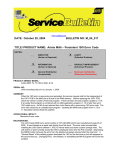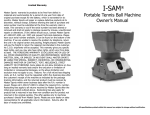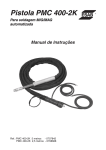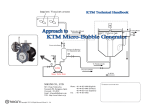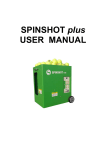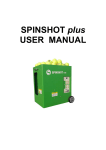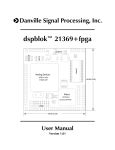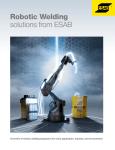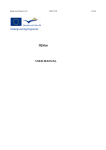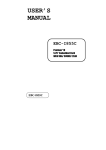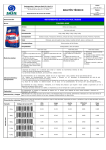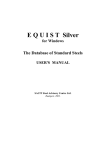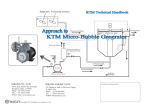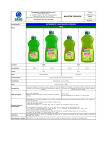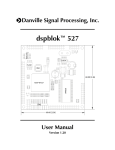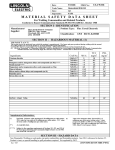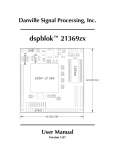Download Welder Guide Book - ESAB Welding & Cutting Products
Transcript
Welder Guide Book All-positional rutile flux cored wires for non and low alloyed steels Contents Introduction3 Direction of travel 18 Before you start welding 4 Welding positions 19 Contact tip and gas nozzle 8 Polarity and inductance 10 Vertical up welding techniques 22 Welding parameter setting 11 ASME and EN ISO positions 13 Choice of wire size 14 Recommended parameter settings 2 Split-weave and stringer beads 23 Mechanized welding 24 Grinding26 Troubleshooting27 16 Product AWS A5.20 Shielding Gas Dual Shield 710X E71T-1C-DH8/T-1M / T-9C-DH8/T-9M CO2 Dual Shield 710 X-M E71T-1C/T-1M-DH8 / T-9C-T-9M-DH8 Dual Shield II 711X E71T-1C-JH8 / T-12C-JH8 Dual Shield II 712X E71T-1M-JH8 / T-12M-JH8 Dual Shield 7100 Ultra E71T-1C-DH8 / T-1M-DH8 T-9C-DH8 / T-9M-DH8 Dual Shield II 70 Ultra E71T-1M / T-9M / T-12M Dual Shield II 71 Ultra E71T-1C-J / T9CJ / T-12C-J 75% Ar / 25% CO2 CO2 75% Ar / 25% CO2 CO2 75% Ar / 25% CO2 75% Ar / 25% CO2 CO2 Dual Shield II 70T-12H4 E71T-1M-JH4 / T-9M-JH4 / T-12M-JH4 Product AWS A5.29 75% Ar / 25% CO2 Dual Shield II 80-Ni1H4 Dual Shield 810X-Ni1 E81T1-Ni1M-JH4 E81T1-Ni1C-H8 CO2 Dual Shield 8000-Ni2 E81T1-Ni2C / T1-Ni2M CO2 75% Ar / 25% CO2 Dual Shield 8000-B2 E81T1-B2C / T1-B2M CO2 75% Ar / 25% CO2 Dual Shield II 101-TC E91T1-K2C CO2 Dual Shield II 101H4M E91T1-GM-H4 Dual Shield 9000-C1 E91T1-Ni2C / T1-Ni2M CO2 75% Ar / 25% CO2 Dual Shield 9000-D1 E91T1-D1C / T1-D1M CO2 75% Ar / 25% CO2 Dual Shield 9000-M E91T1-K2C / T1-K2M CO2 75% Ar / 25% CO2 75% Ar / 25% CO2 75% Ar / 25% CO2 Introduction This guide provides practical information on the use of the ESAB all-positional rutile flux cored wires listed below. When correctly applied, these wires provide: -- Excellent weldability with spray arc droplet transfer in all welding positions. -- Good weld appearance with smooth weld metal wetting. -- High productivity, especially in vertical-up position. -- Defect free welds with good mechanical properties. -- Low-hydrogen weld metal. 3 Before you start welding In order to fully benefit from the excellent weldability of ESAB all-positional rutile flux cored wires, the welding equipment needs to be maintained in good condition. The following checklist serves as a guide. CHECKLIST Contact tips and gas nozzle Remove spatter and replace worn or damaged contact tip. Correct Grind the end of the liner conically for optimal fitting of the contact tip (ESAB M8). Contact tip size, liner size and wire diameter Ensure that the contact tip is the correct size and fits tightly. Ensure the gas nozzle is free from spatter. Shown with gas diffuser. 4 Incorrect Liner Spiral steel liners are recommended. Ensure that the liner has the correct inner diameter for the wire size being used. Check liners regularly for kinks and excessive wear and replace when needed Clean liners regularly using compressed air. Note: Remove contact tip prior to cleaning. Gas and water Check gas and water connections for leaks. Check if water cooler is filled and pump operates properly. Note: If equipped with water cooled torch. Wire feed unit Position wire guide tubes as close as possible to the rollers to prevent kinking of the wire. Correct A substantial amount of fine metallic shavings underneath the drive rolls indicates misalignment or excessive drive roll pressure. Incorrect 5 Before you start welding Use v-groove drive rolls for solid wires. Use knurled drive rolls for flux cored and most metal cored wires. Knurled drive rolls typically increase wear on contact tip and liner assemblies and will likely need to be replaced more often. Check that the groove size is correct for the wire diameter. Apply the correct pressure on feed rolls. Too much pressure flattens the wire, resulting in feedings problems and higher liner and contact tip wear. Insufficient pressure may cause wire to slip in the feed rolls, resulting in irregular feeding and possible wire burnback. Check that the wire is feeding correctly from the contact tip. 6 Smooth v-groove Knurled v-groove Shielding gas Check that the appropriate gas is used (page 3). Adjust gas flow rate between 30 and 40 cfh (15 and 20 l/min). Use 40 cfh (20 l/min) when welding outside. Check that the gas flow from the gas nozzle is at the recommended rate. R-33 FM580 regulator flowmeter Check the gas flow rate again if the gas nozzle diameter is changed. 7 Contact tip and gas nozzle 5/64 in (2mm) Correct positioning of contact tip. It is essential to fit the gas nozzle and contact tip at the right distance relative to each other. The ideal distance of the contact tip is 5/64 in (2mm) recessed. A longer distance will force the welder to use too long of a stick-out, resulting in poor weldability. This may lead to lack of fusion and slag entrapment, particularly in narrow joints. Contact tips protruding beyond the gas nozzle can result in insufficient gas shielding. Incorrect. Contact tip too recessed. Incorrect. Contact tip protruding beyond gas nozzle. 1/2 (15 3/4 in -20 mm ) Ideal stick-out for wire diameters .045 and .052 in (1.2 and 1.4mm) 3/4 - 1 in for ø 1/16 in (20-25mm for ø 1.6mm). 8 Correct stick-out length The stick-out is the distance between the contact tip and workpiece and must be kept between 1/2 to 3/4 in (15 to 20mm) for .045 and .052 in diameters (ø1.2 and 1.4mm). Excessive stickout results in too short of an arc length, larger droplets, unstable arc, and splatter which causes poor weldability. If the stick-out is too short, the current will increase and possibly cause undercut. Gas nozzle diameter Various nozzle diameters must be available to allow satisfactory access to the joint, to maintain the above recommended stick-out, and to ensure proper shielding gas protection. Small diameter gas nozzles are used for the first layers only. Revert to the standard gas nozzle diameter when access to the weld joint allows this, so full gas protection can be assured. 1/2 (15 3/4 in -20 mm ) Correct. Use a smaller diameter nozzle or a conical nozzle for the 1st layers in the root area. >3 / (20 4 in mm ) Incorrect. Use of standard gas nozzle restricts access to narrow joints, resulting in too long a stick-out Correct. Use of standard gas nozzle for completing the joint ensures good gas protection and correct stick-out. 9 Polarity and inductance Always use DCEP (DC electrode positive) polarity for ESAB allpositional rutile flux cored wires. DC ELECTRODE POSITIVE ESAB all-positional rutile flux cored wires operate in the spray arc mode at all welding currents, so no inductance is needed. Switch off the inductance or select minimum setting if the inductance can not be disconnected. Correct. Minimum inductance setting selected. 10 Welding parameter setting A given welding current requires a specific arc voltage for optimum weldability. The welding current is set by adjusting the wire feed speed control. The arc voltage is regulated by the voltage setting of the power source. Pages 16 and 17 give average parameters for various wire diameters and welding positions. Correct. Correct arc length. Stable and concentrated arc with a quiet spray droplet transfer. Achieving the optimum setting For the following procedure, it is vitally important to keep the stickout constant within the correct range for each welding position -- From the range given in the table on pages 16 and 17, select a welding current (I) which suits your application. Incorrect. Arc length too short. Wire dips into weld pool (stubbing) caused by too low an arc voltage, too high a wire speed or too long a stick-out. -- Start welding with the lowest voltage value from the given range. This may result in stubbing, however wire burnback will be avoided. Incorrect. Arc length too long. Arc becomes too wide, giving insufficient penetration and a risk of slag traps. Also a risk of burnback to the contact tip. This may be caused by the arc voltage being too high, the wire feed speed too low or the stick-out being too short. 11 -- Increase the arc voltage in steps of 1 or 2V, until the arc becomes stable, smooth and spatter free, with a slightly crackling sound. Ensure the correct stick-out length is maintained. -- If a different current is required, i.e change of welding position, the procedure described on the previous page needs to be repeated. -- The table on pages 16 and 17 gives settings for 75% Ar/25% CO2 mixed gas. The arc voltage needs to be increased by 1-2V when CO2 shielding gas is being used. Note that the CO2 arc is not as smooth, with a more globular droplet transfer and more spatter. NOTE: As mentioned, stick-out control is very important. If the recommended stick-out length is not maintained constant, weldability will fluctuate. Shortening the stick-out will result in an increasing current and a longer arc. Lengthening the stick-out will result in a lower current and the arc being too short. 38 36 34 Voltage (v) 30 28 Weld too narrow 26 24 22 20 18 1/16 in. (1.6mm) dia.= 3/4 to 1 in. (20-25mm) s/o* z Weld voltage too low small narrow weld 100 * stick-out 12 Excessive weld metal, difficult to control Good weld shape 32 150 .052 in. (1.4mm) dia. = 1/2 to 3/4 in. (15-20mm) s/o* .045 in. (1.2mm) dia. = 1/2 to 3/4 in. (15-20mm) s/o* 200 250 300 350 Current (amps) 400 450 500 ASME and EN ISO positions 2G/PC 1G/PA 4G/PE 3G/PF&PG 5G/PF&PG 6G/HL045 1F/PA 3F/PF&PG 2F/PB 4F/PD 13 Choice of wire size The diameter range of ESAB allpositional rutile flux cored wires is .045-1/16 in (1.2-1.6mm), allowing optimal productivity for various combinations of plate thicknesses and welding positions. Diameter .052 in (1.4mm) provides a useful compromise between productivity and the use of a single diameter wire for all welding positions. The table on page 15 shows suitable recommendations for each diameter. Vertical down welding is not recommended, particularly on PF/3G butt weld in 3/4 in (18mm) plate. Root pass on ceramic backing. 14 thicker plate material > 3/16 in (5mm), because of the risk of lack of fusion. Single-sided root pass welding All-positional rutile flux cored wires are not suited for welding singlesided open root passes. In many applications, however, high quality single-sided root passes in V-joints can be produced very economically on ceramic backing materials. Always use ceramic backing with a rectangular groove. Position Ø .045 in (1.2mm) Ø .052 in (1.4mm) Ø 0.62 in (1.6mm) – 1F/PA Suitability for a typical application yes yes2 – 2F/PB yes – 3F↑/PF yes – 4F/PD yes 2 yes yes yes yes yes yes yes Root 1G/PA Fill 1G/PA on backing yes2 on backing yes not recommended yes Root 2G/PC Fill 2G/PC on backing yes on backing yes not recommended yes Root 3G/PF Fill 3G/PF on backing yes on backing3 yes not recommended possible3 Root 4G/PE Fill 4G/PE no yes no yes3 no not recommended Root 5G/PF Fill 5G/PF no yes no yes3 no not recommended Root 6G/PF Fill 6G/PF no yes no yes no not recommended 1 1 1 One-sided root pass on ceramic backing, V-joint. Centerline cracking may occur at welding currents over 200A, see page 31. 2 .052 and .062 in (1.4 and 1.6mm) sizes will improve productivity. 3 .045 in (1.2mm) size is preferred. 15 Recommended parameter settings Position .045 in (1.2mm) wire diameter ½ - ¾ in (15 - 20 mm) stick-out 1F/2F 3F/4F Current (A) 180-300 WFS (ipm) WFS (m/min) Volts* 240-550 6.0-14.0 24-31 180-250 240-400 6.0-10.0 23-28 1G Root** Fill 180-200 240-320 180-280 240-470 6.0-8.0 6.0-12.0 23-26 25-31 2G Root** Fill 180-210 180-260 6.0-8.5 6.0-10.0 23-26 25-29 3G Root** Fill 180-220 240-330 180-240 240-350 6.0-8.5 6.0-9.0 23-27 24-28 4G Root Fill no 180-260 240-400 6.0-10.0 24-28 Root Fill no 180-240 240-350 6.0-9.0 24-28 Root Fill no 180-240 240-350 6.0-9.0 24-28 5G 6G 240-330 240-400 * Arc voltage valid for 75% Ar/25%CO2 mixed gas. Increase arc voltage 1-2V for CO2. ** On ceramic backing. ***Not recommended. 16 .052 in (1.4 mm) wire diameter ½ - ¾ in (15 - 20 mm) stick-out 1/16 in (1.6 mm) wire diameter ¾ - 1 in (20 - 25 mm) stick-out Current (A) 190-340 WFS (ipm) WFS (m/min) Volts* 180-420 4.5-10.5 24-32 Current (A) WFS (ipm) WFS (m/min) Volts* 200-400 155-420 4.0-10.5 25-35 190-240 180-240 4.5-6.0 24-28 3F: 220-250 200-230 4F: 200-250 155-230 *** 190-340 175-420 4.4-10.5 24-32 *** 210-400 180-210 190-300 155-200 175-340 4.0-5.0 4.4-8.5 23-27 24-32 180-210 190-240 155-220 175-245 4.0-5.5 4.4-6.2 23-27 24-29 *** 190-240 180-240 4.5-6.0 24-28 *** 190-240 180-240 4.5-6.0 24-28 *** 190-240 180-240 4.5-6.0 24-28 5.0-5.8 4.0-5.8 24-28 25-29 180-420 4.5-10.5 25-35 190-220 210-320 145-200 180-320 3.7-5.0 4.5-8.0 25-28 25-33 *** 220-250 200-240 5.0-6.0 24-28 *** *** *** 17 Direction of travel To ensure good penetration and to prevent slag running ahead of the weld pool: Always weld with a backhand angle. A forehand weld can deliver a reasonable appearance, but penetration is often poor. There is also a chance of slag running ahead of the weld pool, causing slag traps and lack of fusion. The same is valid for backhand when the torch angle is too small. Direction of travel. 70-800 Correct: Backhand with torch angle at 70-80°. Direction of travel. Incorrect: Forehand welding. Direction of travel Incorrect: Backhand with the torch angle too small. 18 Welding positions The following are typical situations where the correct torch position plays an important role in avoiding weld defects. 2F/PB - horizontal-vertical fillet The photo shows the ideal torch position, using the recommended backhand technique. Still, undercut and sagging faults can occur in this position. The possible causes of these faults are listed below. Undercut: -- Welding current too high. -- Arc voltage too high. -- Travel speed too fast. -- Arc positioned too close to the vertical plate. -- Torch angle (α) too small. -- Stickout too long. Sagging: -- Welding current too high. -- Arc voltage too high. -- Torch angle (α) too large. -- Layer too thick. -- Travel speed too slow. -- Stickout too short. 450 70-800 α α 19 2G/PC - horizontal-vertical The correct torch position will depend on plate thickness and joint angle. If the torch positions shown cannot be used, it is recommended that the joint angle or root gap is increased. 300 A. Root pass welded on round ceramic. Avoid beads that are too thick. Always maintain the torch angle of 70-80° relative to the weld bead and direction of travel as advised on page 18. Maintain a steady travel speed to achieve a regular bead thickness without sagging. 450 B. 2nd pass positioned towards horizontal plate. 450 100 C. 3rd pass completes 2nd layer. 100 E. 5th pass. Note how layers are always built-up from the bottom side as weld thickness increases. 20 D. 4th pass creates a favorable platform for the following passes. Avoid sagging Sagging (rollover) is typically caused by: -- Travel speed too slow. -- Incorrect torch angle. -- Welding current too high. -- Wrong weld bead sequence. Sagging requires grinding to avoid defects when welding subsequent passes. Avoid sagging but if it occurs then grind back to dotted line as shown above. 3G↑/3F↑/PF - vertical up ESAB all-positional rutile flux cored wires can weld a 3/16 in (4mm) throat fillet weld at welding speeds up to 7 ipm (18cm/min) without weaving. For butt welding in the vertical up position, root passes are deposited onto ceramic backing materials with a rectangular groove. The joint angle must allow good access to the root area. If access is restricted then use a narrower gas nozzle. 100 Root pass 100 Fill pass(es) 21 4G/PE 4F/PD - overhead Use a stick electrode for the root pass and fill with ESAB all-positional rutile flux cored wires. Photo right gives the ideal torch positioning. 80-900 900 Vertical up welding techniques Full width weaving Travel direction Full width weaving is commonly practiced with ESAB all-positional rutile flux cored wires. However, care must be taken to ensure that the heat input is not excessive, otherwise weld metal impact properties may deteriorate. The weaving technique involves crossing the joint from edge to edge in a straight line, while gradually moving upwards in the direction of travel. 22 Split weave and stringer beads. The split weave and stringer bead techniques should be used where optimal subzero weld metal Full width weaving: high heat input toughness properties are required. (e.g. offshore fabrication) Split weave: medium heat input better toughness Stringer beads: low heat input best toughness Heat input Full width weaving: 2.5-3.5 kJ/mm Split weave: 1.5-2.5 kJ/mm Stringer bead: 1.0-1.5 kJ/mm 23 Mechanized welding Mechanized welding is a great way to fully benefit from the productivity of ESAB all positional rutile flux cored wires. It allows higher welding currents and travel speeds which are not manageable in manual welding, while monotonous work is avoided. The ESAB range of light mechanization equipment for MIG/MAG and FCAW consists of: -- ESAB Miggytrac for horizontal welds. -- ESAB Railtrac for horizontal and horizontal vertical welds. -- ESAB Railtrac orbital for circumferential joints ESAB Miggytrac 24 ESAB Railtrac ESAB Railtrac Orbital for circumferential joints. 25 Grinding Grinding may be necessary to correct weld metal sagging or beads which are too convex. Remove only the most obvious irregularities and avoid making deep grooves. They can lead to slag traps and lack of fusion when welding subsequent passes. Root pass treatment When welding double-sided joints, ensure that grinding is done to remove the root pass from the first side to sound metals before welding the first pass on the second side. Correct Correct Incorrect Incorrect. Grinding wheel pushed into root, resulting in a deep groove. The narrow joint is almost inaccessible to the torch. Always grind stop-start areas. 26 Troubleshooting Process faults Although good equipment maintenance and good welder training will help prevent process faults, they can never be avoided completely. In such cases, understanding the most common causes will help the welder to solve any problems quickly. Listed below are the most common process faults and their likely causes. Process faults Likely causes 1. wire stubbing - incorrect parameters - Volts too low for wire feed speed or wire feed speed too high for volts - spool brake too tight - incorrect parameter settings - damaged/worn contact tip - incorrect machine burn back setting - slipping in feed rolls - incorrect parameter settings - wrong shielding gas - incorrect gas flow - erratic wire feed - damaged or worn contact tip - roll pressure too low, causing wire slippage - roll pressure too high, deforming the wire - worn drive rolls - misalignment of rolls or guide tubes - damaged or worn liner - incorrect liner type/diameter - incorrect contact tip size - damaged or worn contact tip - spool brake too tight - spool brake too loose (tangled wire) 2. wire burn-back 3. excess spatter 4. erratic wire feed 5. unstable arc - incorrect parameters - erratic wire feeding - incorrect gas flow - magnetic arc blow, due to poor work cable 27 Troubleshooting Weld defects Lack of fusion defects There are several types of lack of fusion defects, but all share the same feature in that deposited weld metal has not fused with the parent metal or previously deposited weld metal. Typical forms of lack of fusion are shown in a V-butt weld. They can also occur in other types of butt joints. Also shown is a typical side wall defect in a fillet weld. cold lap lack of interrun fusion lack of root fusion lack of side wall fusion Lack of fusion defects Possible causes General -- travel speed too high -- wrong parameter setting -- forehand technique Remedies - reduce travel speed/allow more dwell time at edges - adjust parameters - backhand technique, 70-80° torch angle. Lack of root fusion* - enlarge root gap Fillet: lack of fusion at standing leg -- Torch directed too much towards horizontal leg - change torch orientation *use of ceramic backing is recommended for single-sided root pass welding, see page 14. 28 Lack of penetration This occurs when the weld metal fails to extend into the complete root area of a joint. Shown below are two typical cases. lack of root penetration Lack of penetration Possible causes General -- welding current too low -- arc voltage too high -- travel speed too high -- travel speed too low -- forehand technique -- torch angle too small Butt welds - incorrect joint preparation -- root gap too small -- included joint angle too small Remedies - increase wire feed speed and arc voltage - reduce arc voltage - reduce travel speed - Increase travel speed; avoid slag running ahead of weld pool; stay on front edge of puddle - use backhand technique - use correct angle relative to joint, see page 21; aim the arc at the leading edge of the pool - increase gap - reduce face - increase angle 29 Troubleshooting Porosity Possible causes Remedies -- draft/wind - close doors or windows and check fans. Use shielding tents if outside - clean and dry plates in the weld area - clean/replace - replace - use larger gas nozzle - adjust flow rate - check by blocking gas cup; aspirate air continued gas flow indicates leaks - check connections - check positioning of contact tip distance too long relative to gas cup; readjust parameters --adjust flow rate ------- paint, grease or dirt gas nozzle / diffuser clogged gas nozzle / diffuser distorted gas nozzle / diffuser too small gas flow too high gas leaks in system -- water leaks in cooled guns -- gas cup to workpiece -- gas flow too low Slag inclusions Slag inclusions occur when molten slag is allowed to run ahead of the welding arc and gets trapped below the solidifying weld pool. All-positional rutile flux cored wires are prone to this, because of their fast freezing slag and their easy weldability. The most likely welding positions for slag inclusions to occur are the 1G/PA and 2G/PC positions, particularly in joint preparations with a small included angle. It is important is to control the 30 penetration. To obtain sufficient penetration, welders must use the correct stick-out and arc length. If the arc voltage is too high and/or the stick-out length too short then penetration will be reduced. Also, travel speed has an important influence on penetration and must be fast enough to secure good penetration and to avoid slag running ahead of the weld pool (1G & 2G) and weld metal sagging (2G). Slag inclusions Possible causes Remedies -- welding current too low -- arc voltage too high -- travel speed too low - increase welding current - reduce arc voltage - increase travel speed; avoid slag running ahead of weld pool - use dragging technique - use 70-90° torch angle; keep slag behind arc - increase arc voltage or apply some weaving -- forehand technique -- torch angle too small -- convex beads Centerline cracking on ceramic backing When welding root passes on ceramic backing strips, centerline cracking (hot cracks) may occur in 1G/PA position. If the current and voltage are too high, a concave bead shape may be formed which, combined with high shrinkage forces, can result in centerline cracking. To avoid centreline cracking, the following guidelines must be observed: -- Apply a joint angle of 50-60° and 1/16 to 3/16 in (4-5mm) root opening. -- Use ceramic backing with a rectangular groove. The groove width must be around 5/8 in (15mm). -- Use welding currents below 200A for .045 in (1.2mm) and a low enough arc voltage in order to obtain a flat or slightly convex bead profile. -- A bead depth to width ratio of 1/1 will help avoid centerline cracking. Centerline crack. See page 14 for a correct root pass welded on ceramic backing. 31 Unrivaled service and support. Every ESAB product is backed by our commitment to superior customer service and support. Our skilled customer service department is prepared to quickly answer any questions, address problems, and help with maintenance and upgrading of your machines. Our products are backed with the most comprehensive warranty in the business. With ESAB, you can be sure that you purchased a machine that will meet your needs today and in the future. Product and process training is also available. Ask your ESAB sales representative or distributor for a complete ESAB solution. NOTICE: Test results described above were obtained under controlled laboratory conditions, and are not guarantees for use in the field. Actual use of the product may produce varying results due to conditions and welding techniques over which ESAB has no control, including but not limited to plate chemistry, weldment design, fabrication methods, wire size, welding procedure, service requirements ad the environment. The user should confirm by qualification testing, or other appropriate means, the suitability of any welding consumable and procedure before use in the intended application. GEN-26802 2/11 CAUTION: Users should be thoroughly familiar with the safety precautions referenced in the product label for the relevant product and the Safety Data sheet for the product. Safety Data Sheets are available at esabna. com or by calling 800-ESAB-123. ESAB Welding & Cutting Products / esabna.com / 1.800.ESAB.123 USA: P.O. Box 100545, 411 South Ebenezer Road, Florence, SC 29501-0545 Canada: 6010 Tomken Road, Mississauga, Ontario L5T-1X9 Mexico: Ave. Diego Díaz de Berlanga No. 130, Col. Nogalar San Nicolás de Los Garza N.L. CP 66480 Monterrey, Mexico Find us facebook.com/esabna twitter.com/esabna youtube.com/esabweb The ESAB group is certified according to ISO 14001 & OHSAS 18001
































